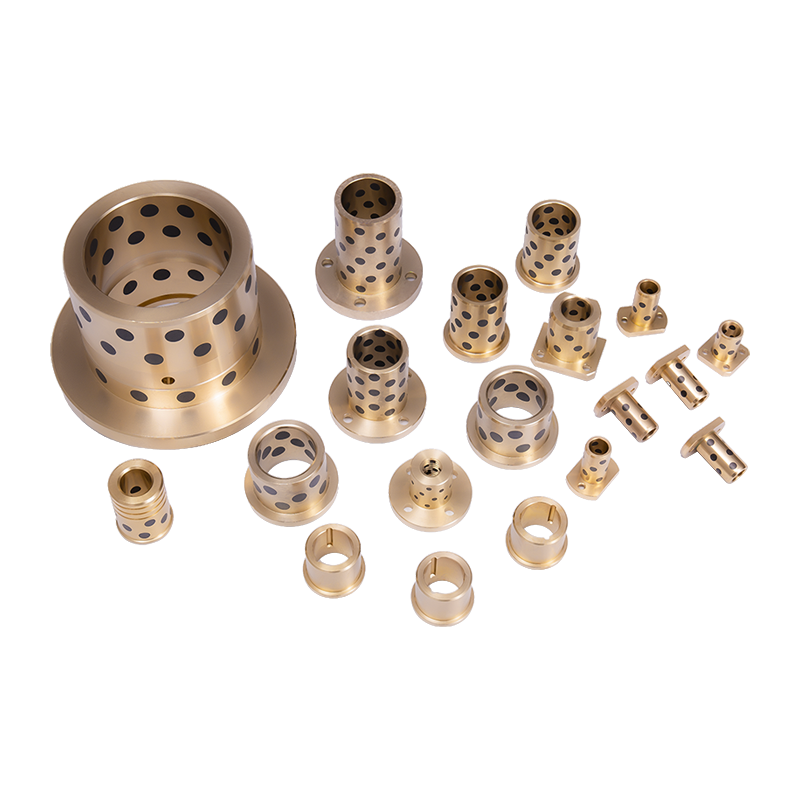DU bushings are a type of self-lubricating bearing, which are widely used in many industrial and mechanical applications for their reliability, efficiency, and low-maintenance properties. The DU in DU bushings stands for “Dry Use” or “Durable Use,” indicating their ability to operate under conditions where traditional lubrication may be difficult to maintain or unnecessary. Let’s dive deeper into the material properties, structure, manufacturing process, and applications of DU bushings.
1. Composition of DU Bushings
DU bushings are primarily made up of two key materials: sintered bronze and PTFE (polytetrafluoroethylene), with some variations involving additional additives. Here’s a breakdown of these materials:
-
Sintered Bronze Backing:
The sintered bronze forms the core of the DU bushing. It is made from fine bronze powder that is compressed and sintered (heated to a point below its melting point) to form a porous material. The porosity of the sintered bronze allows it to retain a small amount of lubricant, improving the wear resistance and allowing for smoother operation. Bronze is chosen because of its excellent load-bearing capacity, corrosion resistance, and strength. -
PTFE Liner (or Solid Lubricant):
PTFE, often referred to by the brand name Teflon, is a non-stick polymer with exceptional low friction properties. It is used as a liner in DU bushings because it reduces friction between moving parts. In DU bushings, PTFE is usually embedded into the sintered bronze backing during the manufacturing process. The PTFE layer acts as the primary lubricant, which means that the bushing does not require additional grease or oil for smooth operation. -
Additional Additives:
Depending on the specific requirements of an application, the PTFE layer in DU bushings can be enhanced with other materials like graphite, molybdenum disulfide, or ceramic particles. These additives help further improve wear resistance, reduce friction, and enhance the overall performance in specific environments.
2. How DU Bushings Work
The operation of DU bushings relies on the unique combination of sintered bronze and PTFE. Here’s how they function:
-
Self-Lubrication: The primary benefit of DU bushings is their self-lubricating feature. The PTFE layer embedded in the sintered bronze material allows the bushing to perform without the need for additional grease, oil, or external lubrication. The PTFE reduces friction by creating a smooth surface between the moving parts, eliminating the need for regular maintenance associated with lubrication.
-
Load Distribution: The sintered bronze acts as a load-bearing material, distributing the load over a larger surface area. The bronze’s porosity helps retain lubricant (such as oil or grease) that might be initially added, and this helps to keep the friction low and the bushing running smoothly under high-pressure conditions.
-
Wear Resistance: Over time, the PTFE liner gradually wears away, but because the bushing’s structure includes a bronze backing, it continues to function even as the PTFE layer wears down. This makes DU bushings extremely durable and able to operate under harsh conditions without failing quickly.
3. Advantages of DU Bushings
DU bushings offer numerous advantages that make them a preferred choice for many applications:
-
Maintenance-Free: The self-lubricating nature of DU bushings eliminates the need for continuous lubrication, which can be messy and time-consuming. This makes DU bushings particularly useful in hard-to-reach areas or machinery where frequent lubrication is impractical.
-
High Load Capacity: The sintered bronze backing provides excellent load-bearing capacity, allowing DU bushings to handle heavy-duty applications without deformation or failure.
-
Low Friction: The PTFE lining minimizes friction between moving parts, improving efficiency and reducing wear on the equipment. This characteristic is especially important in high-speed or precision applications.
-
Corrosion Resistance: Bronze is inherently resistant to corrosion, and the PTFE lining is chemically inert, making DU bushings ideal for use in environments exposed to moisture, chemicals, or corrosive substances.
-
Durability: DU bushings have a long operational lifespan due to the combination of wear-resistant materials. The sintered bronze backing provides mechanical strength, while the PTFE liner ensures smooth operation and low friction.
-
High-Temperature Performance: DU bushings can operate effectively at high temperatures due to the heat-resistant properties of both the bronze backing and the PTFE liner.
-
Versatility: These bushings can be customized for various industrial applications, including those with specific lubrication needs or operating conditions. They are available in a range of sizes, from small to large diameters, and can be machined or fabricated to meet specific design requirements.

4. Common Applications of DU Bushings
DU bushings are commonly used in applications where traditional lubrication would be difficult to maintain or where parts are subject to heavy loads and high wear. Some key industries and uses include:
-
Automotive: DU bushings are widely used in automotive suspension systems, steering mechanisms, and other parts where high load-bearing capacity and low friction are essential. They help improve vehicle longevity by reducing the need for frequent maintenance.
-
Industrial Machinery: In equipment such as conveyors, pumps, presses, and rollers, DU bushings provide reliable, long-lasting performance. Their ability to operate without lubrication makes them ideal for use in environments where traditional lubrication methods would be inefficient or challenging.
-
Agricultural Equipment: DU bushings are frequently found in agricultural machinery, such as tractors and harvesters, where external lubrication is difficult to apply due to the rugged and dirty working conditions.
-
Construction and Mining: Construction equipment like bulldozers, cranes, and excavators uses DU bushings in high-wear, heavy-load areas such as joints, hinges, and suspension parts. These bushings can operate in harsh conditions where grease or oil would be washed away by dust, dirt, or moisture.
-
Marine Applications: DU bushings are also commonly used in shipbuilding, especially in rudder and winch systems, where exposure to seawater makes the self-lubricating properties of DU bushings particularly beneficial.
-
Heavy Industry: DU bushings are used in industrial machinery, like turbines, generators, and compressors, which often experience high temperatures, pressure, and loads. The bushing’s high-temperature resistance and load capacity make it ideal for such applications.
5. Types of DU Bushings
DU bushings come in various forms, each suited for specific applications:
-
Plain Bushings: These are the standard form of DU bushings and are used in simple applications where a plain bearing design is adequate.
-
Flanged Bushings: Flanged DU bushings have a flange that provides additional support and helps to maintain proper alignment in the assembly.
-
Sleeve Bushings: These are cylindrical bushings that slide over a shaft and provide smooth rotation while minimizing friction.
-
Custom Shapes: DU bushings can also be custom-designed for specific machinery or applications, allowing manufacturers to produce parts tailored to particular needs.
6. Environmental Considerations
While DU bushings offer many benefits, it’s important to consider their environmental impact. The material is recyclable, but the PTFE liner used in DU bushings may contain chemicals like PFOA or PTFE resin that are harmful if not disposed of properly. There are newer, eco-friendly versions of DU bushings that are designed to be more environmentally conscious, with BPA-free or PFOA-free coatings.
DU bushings are an essential component in modern machinery and industrial applications, offering a combination of durability, low friction, high load capacity, and self-lubrication. Their unique construction, using sintered bronze and PTFE, allows them to operate in harsh conditions without requiring regular maintenance or lubrication. From automotive systems to heavy machinery, DU bushings play a key role in reducing friction, wear, and downtime, contributing to the overall efficiency and longevity of mechanical systems. Whether for industrial equipment, agricultural machinery, or even marine applications, DU bushings offer a reliable and cost-effective solution to complex bearing and lubrication challenges.



 English
English русский
русский Español
Español عربى
عربى


